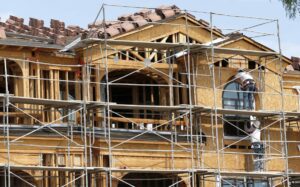Challenges Ahead for Homebuilders: Navigating a Murky Spring Market
As the spring home-selling season approaches, the outlook for major homebuilders is becoming increasingly complex. Heightened mortgage rates and the looming threat of a trade war are leading to a tough environment for those in the home construction sector.
The Rush to Build and Its Consequences
In recent years, many builders have surged to construct new homes, aiming to alleviate the persistent shortage in the resale market created by homeowners hesitant to sell due to high borrowing costs. However, the current economic climate, characterized by elevated mortgage rates and uncertainty, has presented formidable challenges for these builders as they attempt to balance supply with demand.
According to Rafe Jadrosich, a homebuilders and building products analyst at Bank of America Securities, “We expect the challenging environment for homebuilders to persist through the first half of 2025.” This sentiment resonates deeply within the industry, as the cracks in the market begin to surface.
Notable Market Friction
Take, for example, DR Horton (DHI), the largest homebuilder in the nation. D.R. Horton reported a 1% year-over-year decrease in net orders for the first fiscal quarter, totaling 17,837 homes, which was notably below the analysts’ forecast of 18,478 homes.
To stimulate sales, D.R. Horton has started implementing various incentives, including mortgage rate buy-downs and offering smaller homes. However, these strategies are beginning to take a toll on profit margins. The financial impacts are becoming clear, as reported margins fell 90 basis points in December compared to the prior quarter, with expectations of rising costs impacting second-quarter gross margins.
Despite these challenges, D.R. Horton’s CEO Paul Romanowski has expressed hope that the upcoming spring season will mark a pivotal turnaround. “We need the spring to show up for us and to see the sales,” he remarked during a recent earnings call.
Optimism vs. Reality
Jay McCanless from Wedbush Securities shares a glimmer of optimism, noting the potential for a robust selling season if mortgage rates stabilize. However, both McCanless and builders remain wary of the detrimental effects of mortgage rate volatility, which can significantly affect buyer confidence.
Toll Brothers (TOL) is also feeling the strain, as the company has recently adjusted its home delivery expectations downward. They project closing sales between 2,500 and 2,700 in the fiscal second quarter, which is again below analyst expectations. CEO Douglas Yearley alluded to a mixed sales environment thus far this spring.
Increasing Construction Costs
Beyond demand issues, builders face substantial challenges stemming from rising land prices and a competitive marketplace influenced by increased inventory levels. The National Association of Home Builders has reported a staggering 46% increase in ready-to-occupy new homes, suggesting that builders may need to adopt innovative strategies to differentiate themselves in a crowded market.
Moreover, the ramifications of President Trump’s executive order imposing a 25% tariff on imported steel and aluminum could further inflate construction costs. If builders are forced to pass these costs onto consumers, the resulting price increase could deter buyers. Wolfe Research highlights that a mere $10,000 increase in a new home’s price could raise monthly payments by $48, complicating affordability for prospective homeowners.
The Landscape Ahead
In response to these market pressures, smaller builders are exercising increased caution. With a noted decline in homebuilder confidence—evidenced by a five-point drop reaching a five-month low—industry experts like Trevor Allinson from Wolfe Research emphasize that while housing affordability remains a critical concern, land inflation is shaping up to be a more significant headwind.
As builders strategize to navigate these challenging conditions, the interplay of economic variables, including mortgage rates, construction costs, and buyer sentiment will determine the trajectory of the housing market in the coming months.
For an in-depth analysis of the evolving housing market and strategic insights for investors, make sure to check back with the Extreme Investor Network as we continue to provide expert commentary and relevant updates.

